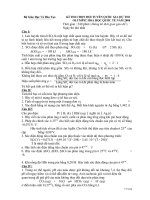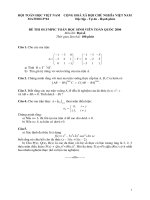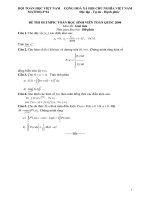Đề thi Olympic Toán học quốc tế BMO năm 2018
Bạn đang xem bản rút gọn của tài liệu. Xem và tải ngay bản đầy đủ của tài liệu tại đây (56.89 KB, 1 trang )
<span class='text_page_counter'>(1)</span><div class='page_container' data-page=1>
British Mathematical Olympiad
Round 1 : Friday, 1 December 2017
Time allowed 31
2 hours.
Instructions <sub>•</sub> Full written solutions – not just answers – are
required, with complete proofs of any assertions
you may make. Marks awarded will depend on the
clarity of your mathematical presentation. Work
in rough first, and then write up your best attempt.
Do not hand in rough work.
• One complete solution will gain more credit than
several unfinished attempts. It is more important
to complete a small number of questions than to
try all the problems.
• Each question carries 10 marks. However, earlier
questions tend to be easier. In general you are
advised to concentrate on these problems first.
• The use of rulers, set squares and compasses
is allowed, but calculators and protractors are
forbidden.
• Start each question on a fresh sheet of paper. Write
on one side of the paper only. On each sheet of
working write the number of the question in the
top left hand corner and your name, initials and
school in the toprighthand corner.
• Complete the cover sheet provided and attach it to
the front of your script, followed by your solutions
in question number order.
• Staple all the pages neatly together in the top left
hand corner.
• To accommodate candidates sitting in other time
zones, please do not discuss the paper on the
internet until 8am GMT on Saturday 2 December
when the solutions video will be released at
Do not turn over untiltold to do so.
2017/18 British Mathematical Olympiad
Round 1: Friday, 1 December 2017
1. Helen divides 365 by each of 1,2,3, . . . ,365 in turn, writing down a list
of the 365 remainders. Then Phil divides 366 by each of 1,2,3, . . . ,366
in turn, writing down a list of the 366 remainders. Whose list of
remainders has the greater sum and by how much?
2. In a 100-day period, each of six friends goes swimming on exactly 75
days. There are n days on which at least five of the friends swim.
What are the largest and smallest possible values ofn?
3. The triangle ABC has AB = CA and BC is its longest side. The
point N is on the side BC and BN =AB. The line perpendicular
to ABwhich passes throughN meets AB atM. Prove that the line
M N divides both the area and the perimeter of triangle ABC into
equal parts.
4. Consider sequencesa1, a2, a3, . . .of positive real numbers with a1= 1
and such that
an+1+an = (an+1<sub>−</sub>an)2
for each positive integern. How many possible values cana2017take?
5. If we take a 2×100 (or 100×2) grid of unit squares, and remove
alternate squares from a long side, the remaining 150 squares form a
100-comb<sub>. Henry takes a 200</sub><sub>×</sub><sub>200 grid of unit squares, and chooses</sub>
kof these squares and colours them so that James is unable to choose
150 uncoloured squares which form a 100-comb. What is the smallest
possible value ofk?
6. Matthew has a deck of 300 cards numbered 1 to 300. He takes cards
out of the deck one at a time, and places the selected cards in a row,
with each new card added at the right end of the row. Matthew must
arrange that, at all times, the mean of the numbers on the cards in
the row is an integer. If, at some point, there is no card remaining in
the deck which allows Matthew to continue, then he stops.
</div>
<!--links-->









